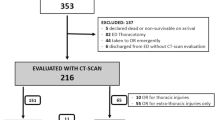Abstract
Background
Chest CT after pediatric trauma is frequently performed but its clinical impact, particularly with respect to surgical intervention, has not been adequately evaluated.
Objective
To assess the impact of chest CT compared with chest radiography on pediatric trauma management.
Materials and methods
Two hundred thirty-five consecutive pediatric trauma patients who had both chest CT and radiography were identified. Images were reviewed and findings were categorized and correlated with subsequent chest interventions, blinded to final outcome and management.
Results
Of the 235 children, 38.3% (90/235) had an abnormal chest radiograph and 63.8% (150/235) had an abnormal chest CT (P < 0.0001). Chest interventions followed in 4.7% (11/235); of these, the findings could be made 1 cm above the dome of the liver in 91% (10/11). Findings requiring chest intervention included pneumothorax (PTX) and vertebral fractures. PTX was found on 2.1% (5/235) of chest radiographs and 20.0% (47/235) of chest CTs (P < 0.0001); 1.7% (4/235) of the children received a chest tube for PTX, 0.85% (2/235) seen on chest CT only. Vertebral fractures were present in 3.8% of the children (9/235) and 66.7% (6/9) of those cases were treated with spinal fusion or brace. There were no instances of mediastinal vascular injury.
Conclusion
Most intrathoracic findings requiring surgical management in our population were identified in the lower chest and would be included in routine abdominopelvic CT exams; this information needs to be taken into consideration in the diagnostic algorithm of pediatric trauma patients.



Similar content being viewed by others
References
Schalamon J, von Bismarck S, Schober PH et al (2003) Multiple trauma in pediatric patients. Pediatr Surg Int 19:417–423
Westra SJ, Wallace EC (2005) Imaging evaluation of pediatric chest trauma. Radiol Clin North Am 43:267–281
Simon B, Letourneau P, Vitorino E et al (2001) Pediatric minor head trauma: indications for computed tomographic scanning revisited. J Trauma 51:231–237, discussion 237–238
Taylor GA, Fallat ME, Potter BM et al (1988) The role of computed tomography in blunt abdominal trauma in children. J Trauma 28:1660–1664
Mirvis SE, Shanmuganathan K, Buell J et al (1998) Use of spiral computed tomography for the assessment of blunt trauma patients with potential aortic injury. J Trauma 45:922–930
Zinck SE, Primack SL (2000) Radiographic and CT findings in blunt chest trauma. J Thorac Imaging 15:87–96
Lowe LH, Bulas DI, Eichelberger MD et al (1998) Traumatic aortic injuries in children: radiologic evaluation. AJR 170:39–42
Holmes JF, Sokolove PE, Brant WE et al (2002) A clinical decision rule for identifying children with thoracic injuries after blunt torso trauma. Ann Emerg Med 39:492–499
Engdahl O, Toft T, Boe J (1993) Chest radiograph—a poor method for determining the size of a pneumothorax. Chest 103:26–29
Marts B, Durham R, Shapiro M et al (1994) Computed tomography in the diagnosis of blunt thoracic injury. Am J Surg 168:688–692
Kuppermann N (2008) Pediatric head trauma: the evidence regarding indications for emergent neuroimaging. Pediatr Radiol 38(Suppl 4):S670–674
Sivit CJ (2008) Contemporary imaging in abdominal emergencies. Pediatr Radiol 38(Suppl 4):S675–678
Neschis DG, Scalea TM, Flinn WR et al (2008) Blunt aortic injury. N Engl J Med 359:1708–1716
Klinkner DB, Arca MJ, Lewis BD et al (2007) Pediatric vascular injuries: patterns of injury, morbidity, and mortality. J Pediatr Surg 42:178–182, discussion 182–183
Tiao GM, Griffith PM, Szmuszkovicz JR et al (2000) Cardiac and great vessel injuries in children after blunt trauma: an institutional review. J Pediatr Surg 35:1656–1660
Manson D, Babyn PS, Palder S et al (1993) CT of blunt chest trauma in children. Pediatr Radiol 23:1–5
Renton J, Kincaid S, Ehrlich PF (2003) Should helical CT scanning of the thoracic cavity replace the conventional chest x-ray as a primary assessment tool in pediatric trauma? An efficacy and cost analysis. J Pediatr Surg 38:793–797
Bliss D, Silen M (2002) Pediatric thoracic trauma. Crit Care Med 30:S409–415
Sivit CJ, Taylor GA, Eichelberger MR (1989) Chest injury in children with blunt abdominal trauma: evaluation with CT. Radiology 171:815–818
Vialle LR, Vialle E (2005) Pediatric spine injuries. Injury 36(Suppl 2):B104–112
Reddy SP, Junewick JJ, Backstrom JW (2003) Distribution of spinal fractures in children: does age, mechanism of injury, or gender play a significant role? Pediatr Radiol 33:776–781
Acknowledgements
Presented at the 52nd annual meeting of the Society for Pediatric Radiology in Carlsbad, CA, April 21–25, 2009. Statistics supported in part by grant M01 RR-00095 from the National Center for Research Resources, National Institutes of Health.
Author information
Authors and Affiliations
Corresponding author
Rights and permissions
About this article
Cite this article
Patel, R.P., Hernanz-Schulman, M., Hilmes, M.A. et al. Pediatric chest CT after trauma: impact on surgical and clinical management. Pediatr Radiol 40, 1246–1253 (2010). https://doi.org/10.1007/s00247-009-1533-x
Received:
Revised:
Accepted:
Published:
Issue Date:
DOI: https://doi.org/10.1007/s00247-009-1533-x




